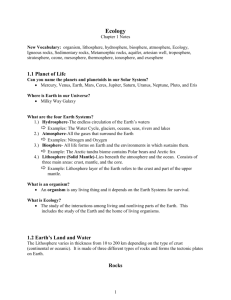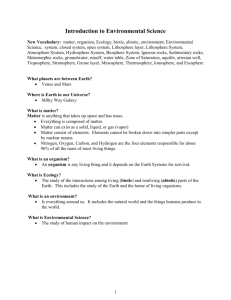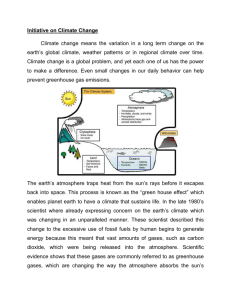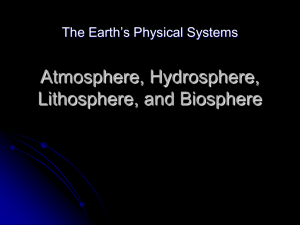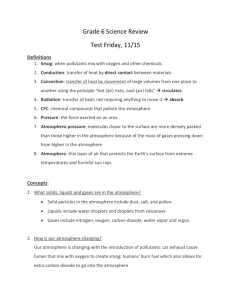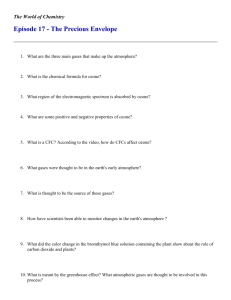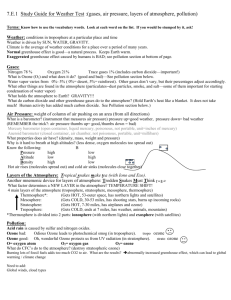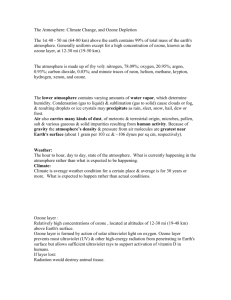Ecology
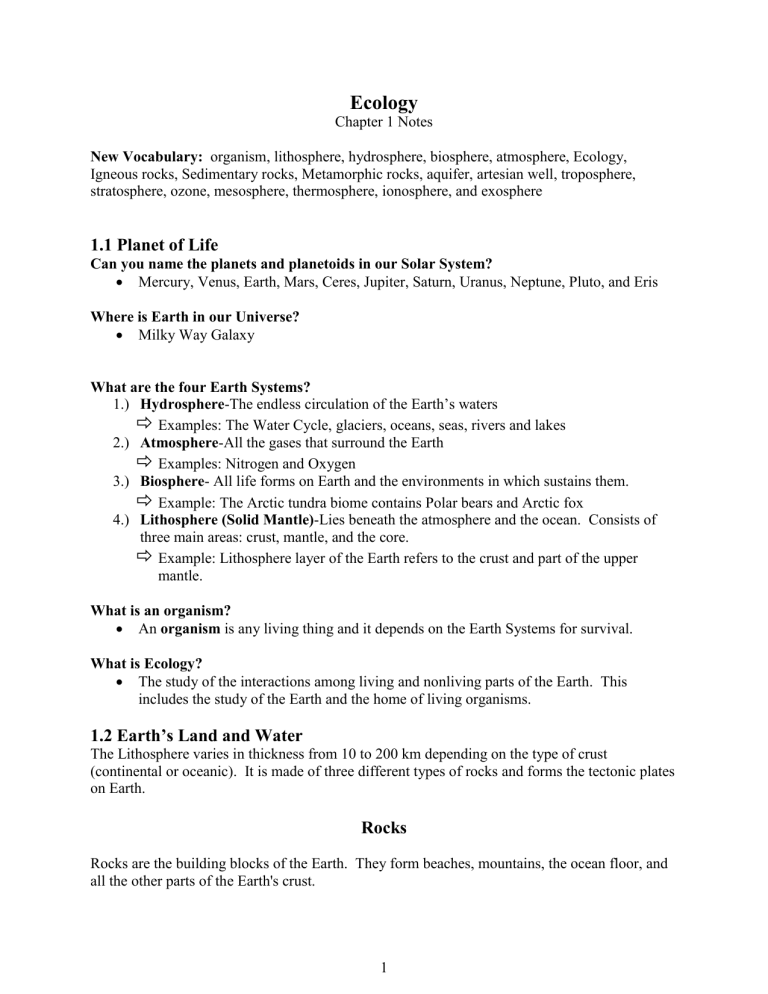
Ecology
Chapter 1 Notes
New Vocabulary: organism, lithosphere, hydrosphere, biosphere, atmosphere, Ecology,
Igneous rocks, Sedimentary rocks, Metamorphic rocks, aquifer, artesian well, troposphere, stratosphere, ozone, mesosphere, thermosphere, ionosphere, and exosphere
1.1
Planet of Life
Can you name the planets and planetoids in our Solar System?
Mercury, Venus, Earth, Mars, Ceres, Jupiter, Saturn, Uranus, Neptune, Pluto, and Eris
Where is Earth in our Universe?
Milky Way Galaxy
What are the four Earth Systems?
1.) Hydrosphere -The endless circulation of the Earth’s waters
Examples: The Water Cycle, glaciers, oceans, seas, rivers and lakes
2.) Atmosphere -All the gases that surround the Earth
Examples: Nitrogen and Oxygen
3.) Biosphere - All life forms on Earth and the environments in which sustains them.
Example: The Arctic tundra biome contains Polar bears and Arctic fox
4.) Lithosphere (Solid Mantle) -Lies beneath the atmosphere and the ocean. Consists of three main areas: crust, mantle, and the core.
Example: Lithosphere layer of the Earth refers to the crust and part of the upper mantle.
What is an organism?
An organism is any living thing and it depends on the Earth Systems for survival.
What is Ecology?
The study of the interactions among living and nonliving parts of the Earth. This includes the study of the Earth and the home of living organisms.
1.2
Earth’s Land and Water
The Lithosphere varies in thickness from 10 to 200 km depending on the type of crust
(continental or oceanic). It is made of three different types of rocks and forms the tectonic plates on Earth.
Rocks
Rocks are the building blocks of the Earth. They form beaches, mountains, the ocean floor, and all the other parts of the Earth's crust.
1
A rock is a mixture of one or more minerals, mineraloids (they do not perfectly fit the definition of a mineral because they lack a crystalline structure), glass, or organic matter.
Common minerals found in rocks: quartz, feldspar, and mica.
Igneous rocks are originally hot, fluid magma within the Earth or lava spewing onto the Earth’s surface.
Sedimentary Rocks are made of sediments of inorganic or organic material either naturally cemented together (cementation) or pressed together (compaction).
Erosion and weathering break up the Earth to form sediments
Metamorphic Rocks are rocks that have changed from one form to another by heat, pressure, and/or chemical processes
The Hydrosphere
Water is the most powerful agent of erosion on the surface and underground.
About 70 % Earth's surfaces are covered with water. i.
97 % Ocean water ii.
2 % Ice caps at the Poles iii.
1 % Fresh water for drinking and growing food.
Water Cycle :
Water constantly moves between the atmosphere and Earth in a cycle.
1.
Evaporation: Water changing from a liquid to a gas because energy causes the molecules to move apart.
2.
Condensation: Water changes from a gas to liquid because molecules cool, and they move closer together to form clouds.
3.
Precipitation: When clouds can not hold anymore water vapor it produces rain, snow, sleet, or hail.
4.
Groundwater: Water soaks into the ground and becomes groundwater or runoff to the rivers and oceans. o Runoff: Water that does not soak into the ground or evaporates.
Affected by the amount of rain
Time rain falls
Slope of the land
Amount of vegetation.
Vegetation tends to soak up and hold water.
Fresh water can be divided in two types: surface and groundwater
Surface water includes runoff from rain, lakes and streams
Groundwater is found below the surface.
2
The groundwater system is similar to a river system, except instead of having connecting channels they have connecting pores.
Groundwater is water that soaks into the ground by the process called infiltration that collects into pores.
Pores are spaces between rock fragments and pieces of weathered rock
Groundwater will keep going to lower elevations until it reaches a layer of impermeable rock.
This rock acts like a barrier and the water can't move down any deeper.
The Zone of Saturation is the area beneath to surface that is saturated with water
The upper boundary of the Zone of Saturation is the water table
An aquifer is a layer of porous rock that contains water under pressure.
This water can reach the surface and form a natural spring
An artesian well is an area of groundwater under high pressure. If a well is drilled into an area like an aquifer the water flows freely to the surface allowing humans to use in their homes.
1.3
The Atmosphere
The atmosphere is an envelope of gases that surrounds the Earth as a mixture of solids, liquids, and gases
Water in the atmosphere exist in three states of matter: water vapor (gas), ice (solid), and water (liquid)
The key two atmospheric gases are Nitrogen 78% and Oxygen 21%
Other gases: 1% (Argon-.93%, CO
2
-0.03%, Water Vapor-0-4%)
Traces: Neon, Helium, Methane, Krypton, Xenon, Hydrogen, and Ozone
Background on the ozone layer:
Before ozone was present in the Earth’s atmosphere, much of the ultraviolet radiation reached the earth’s surface. When that was the case the only life that could have survived would have been found in deep water where it was protected from UV rays of the Sun. Without the ozone layer we and everything else would die.
Ozone is a compound composed of three oxygen atoms bonded together in a triangular bond.
The ozone layer is located about 24 km above you in the Stratosphere
The Ozone Layer acts like a filter to absorbs most of the UV radiation from the
Sun that enters the atmosphere
Atmospheric Layers
1.
Troposphere
We live in it
Contains 75% of all the atmosphere’s gases
Contains dust, ice, and liquid water
Where our weather and clouds occur
3
2.
Stratosphere
Lies above the troposphere
Ozone layer is located here
3.
Mesosphere
Above the stratosphere
Temperature decrease since no concentration of ozone
Where meteors burn up
4.
Thermosphere
Hottest layer-more than 1000 o
C
Has an important sub-layer called the Ionosphere -layer of electrically charged particles i.
When there particles are bombarded by energy from space, ions and free electrons are created. ii.
Useful for communications because they reflect radio waves. iii.
Radio waves from one side of the world can be received on the other side by bouncing off the ionosphere. iv.
When particles of matter from the sun hit this area the ions glow in different colors. The result is visible bands of slimming light called the
Aurora (Northern and Southern Lights)
5.
Exosphere
Uppermost part of the Earth’s atmosphere i.
Gases such as helium and hydrogen are found here ii.
No clear boundary between the exosphere and space. Just very few molecules and ions.
1.4 The Biosphere
The biosphere is all the parts of the Earth that support and contain life.
Comprised of 20 km thick reaching from the bottom of the ocean to the highest mountain tops
All organisms obtain the material they need to live from the biosphere. The biosphere needs the other three Earth systems to survive: Lithosphere, Hydrosphere, and
Atmosphere
4
